Opticks : GPU Optical Photon Simulation for Particle Physics with NVIDIA OptiX
- Opticks: GPU photon simulation via NVIDIA OptiX ;
- Applied to neutrino telescope simulations ?
Opticks : GPU photon simulation via NVIDIA® OptiX™
+ GPU/Graphics background
+ Application to neutrino telescope simulations ?
Open source, https://bitbucket.org/simoncblyth/opticks
Simon C Blyth, IHEP, CAS — August 2020, SJTU, Neutrino Telescope Simulation Workshop
Outline Opticks
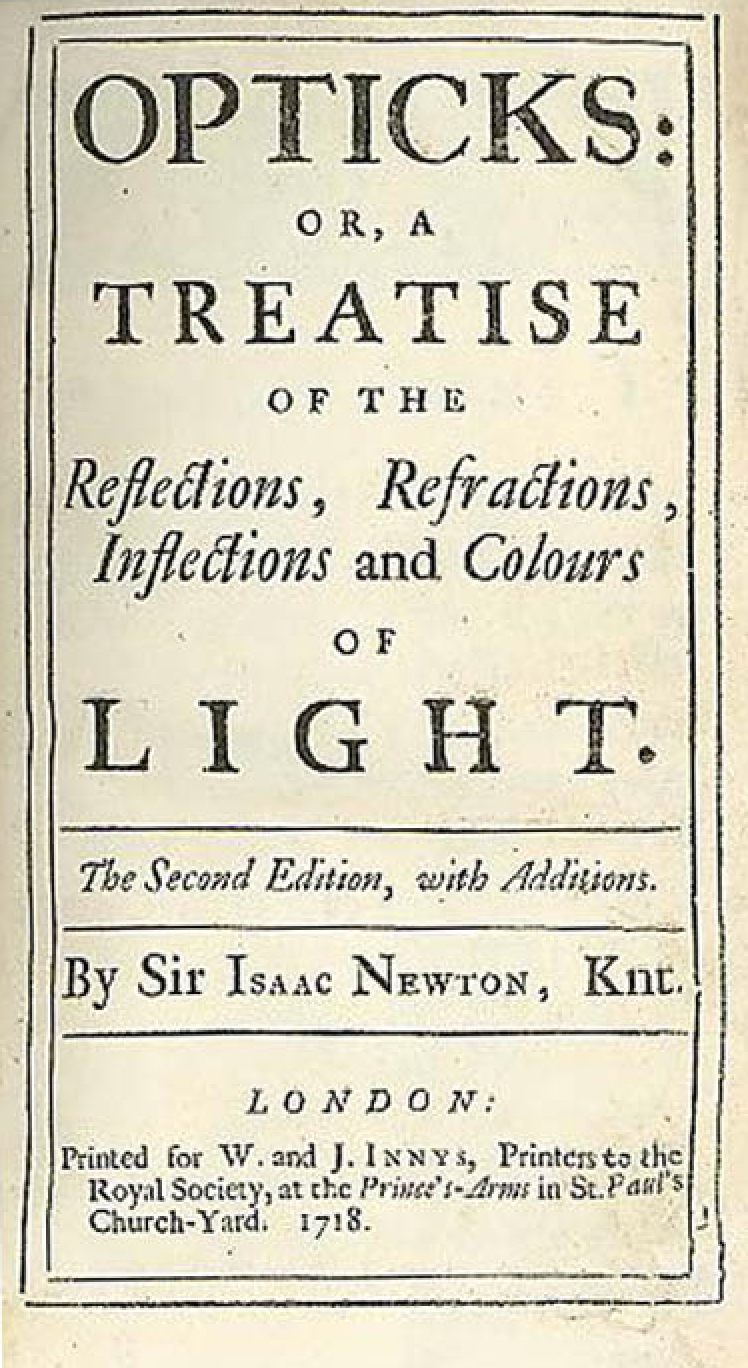
- Context and Problem
- Jiangmen Underground Neutrino Observatory (JUNO)
- Optical Photon Simulation Problem...
- Tools to create Solution
- Optical Photon Simulation ≈ Ray Traced Image Rendering
- Rasterization and Ray tracing
- Turing Built for RTX
- BVH : Bounding Volume Hierarchy
- NVIDIA OptiX Ray Tracing Engine
- Opticks : The Solution
- Geant4 + Opticks Hybrid Workflow : External Optical Photon Simulation
- Opticks : Translates G4 Optical Physics to CUDA/OptiX
- Opticks : Translates G4 Geometry to GPU, Without Approximation
- CUDA/OptiX Intersection Functions for ~10 Primitives
- CUDA/OptiX Intersection Functions for Arbitrarily Complex CSG Shapes
- Validation and Performance
- Random Aligned Bi-Simulation -> Direct Array Comparison
- Perfomance Scanning from 1M to 400M Photons
- Overview + Links
Outline of Graphics/GPU background + Application to neutrino telescopes

- GPU + Parallel Processing Background
- Amdahls "Law" : Expected speedup limited by serial processing
- Understanding GPU Graphical Origins -> Effective GPU Computation
- CPU Optimizes Latency, GPU Optimizes Throughput
- How to make effective use of GPUs ? Parallel/Simple/Uncoupled
- GPU Demands Simplicity (Arrays) -> Big Benefits : NumPy + CuPy
- Survey of High Level General Purpose CUDA Packages
- Graphics History/Background
- 50 years of rendering progress
- 2018 : NVIDIA RTX : Project Sol Demo
- Monte Carlo Path Tracing in Movie Production
- Fundamental "Rendering Equation" of Computer Graphics
- Neumann Series solution of Rendering Equation
- Noise : Problem with Monte Carlo Path Tracing
- NVIDIA OptiX Denoiser
- Physically Based Rendering Book : Free Online
- Optical Simulations : Graphics vs Physics
- Neutrino Telescope Optical simulations
- Giga-photon propagations : Re-usable photon "snapshots"
- Opticks Rayleigh Scattering : CUDA line-by-line port of G4OpRayleigh
- Developing a photon "snapshot" cache
- Photon Mapping
- Summary
JUNO_Intro_2
JUNO_Intro_3
Geant4 : Monte Carlo Simulation Toolkit
Geant4 : Monte Carlo Simulation Toolkit Generality
Standard Simulation Tool of HEP
Geant4 simulates particles travelling through matter
- high energy, nuclear and accelerator physics
- medical physics : deciding radiotherapy doses/sources
- space engineering : satellites
Geant4 Approach
- geometry : tree of CSG solids
- particles : track position and time etc..
- processes : nuclear, EM, weak, optical
Very General and Capable Tool
- mostly unused for optical photon propagation
Optical Photon Simulation Problem...
Huge CPU Memory+Time Expense
- JUNO Muon Simulation Bottleneck
- ~99% CPU time, memory constraints
- Ray-Geometry intersection Dominates
- simulation is not alone in this problem...
- Optical photons : naturally parallel, simple :
- produced by Cherenkov+Scintillation
- yield only Photomultiplier hits
Optical Photon Simulation ≈ Ray Traced Image Rendering
Not a Photo, a Calculation
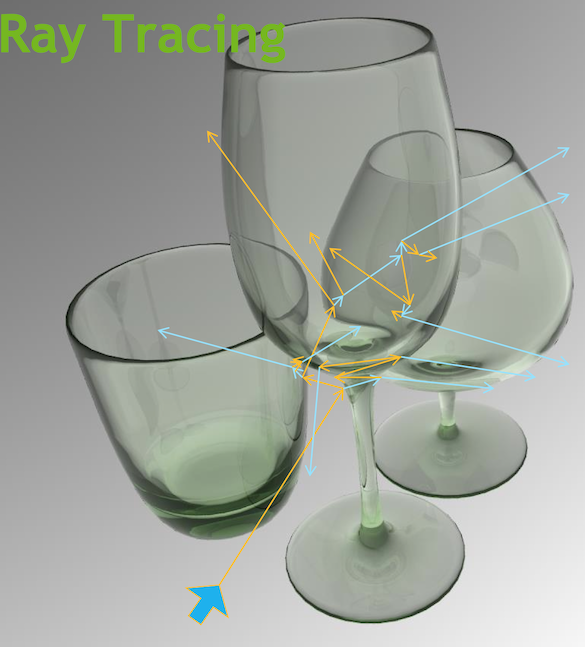
Much in common : geometry, light sources, optical physics
- simulation : photon parameters at PMT detectors
- rendering : pixel values at image plane
- both limited by ray geometry intersection, aka ray tracing
Many Applications of ray tracing :
- advertising, design, architecture, films, games,...
- -> huge efforts to improve hw+sw over 30 yrs
Ray-tracing vs Rasterization
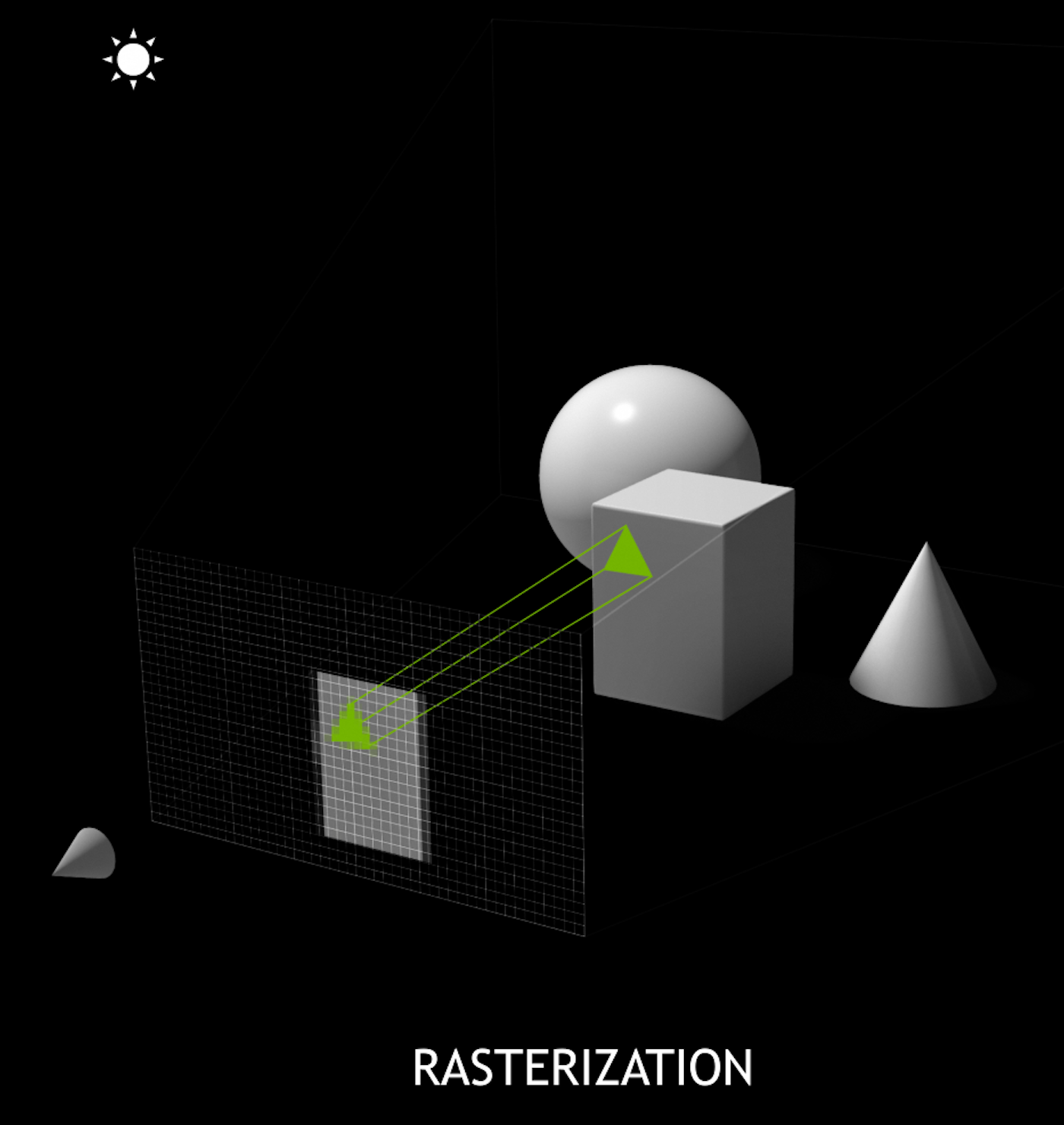
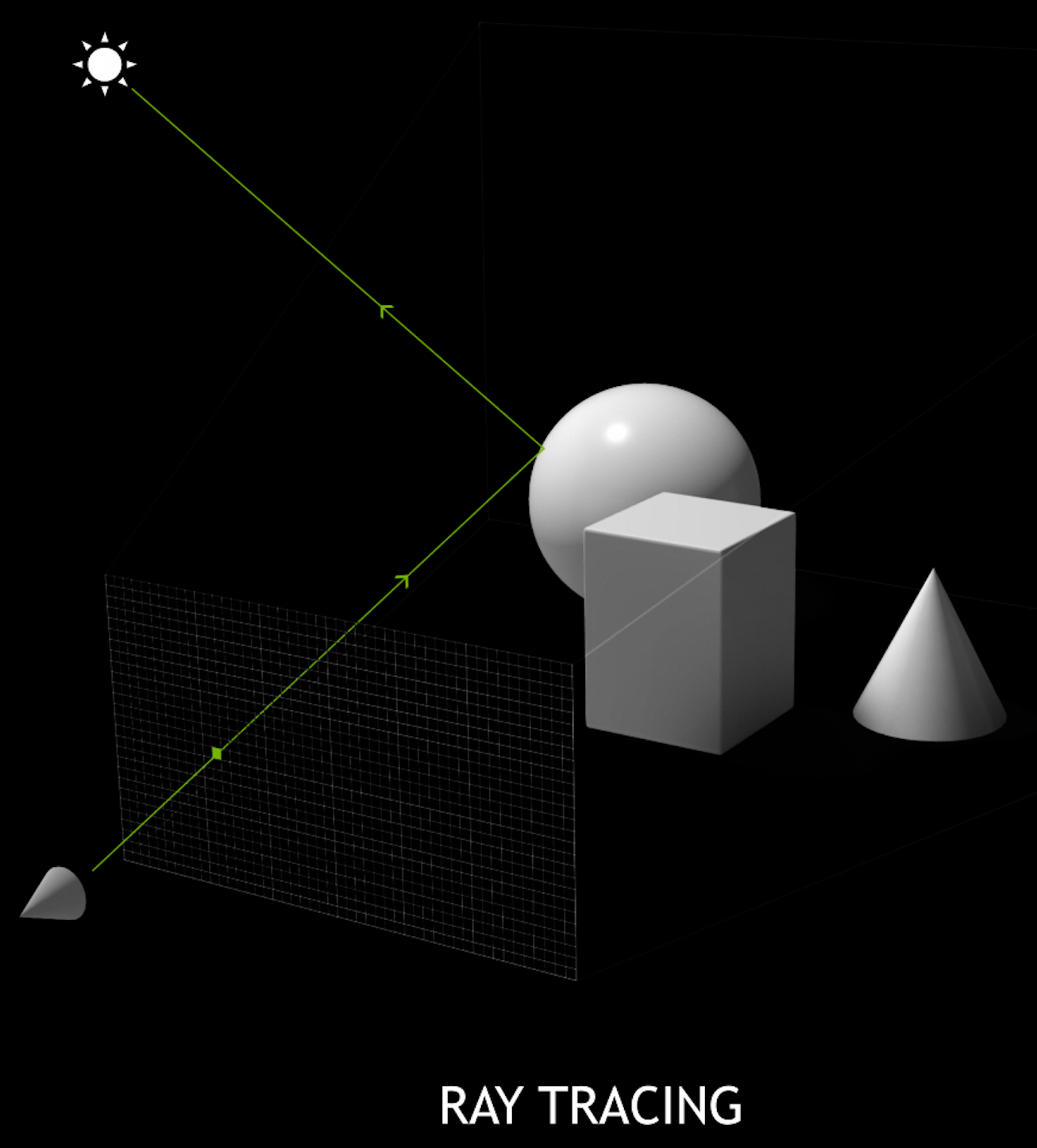
SIGGRAPH_2018_Announcing_Worlds_First_Ray_Tracing_GPU
| 10 Giga Rays/s |
TURING BUILT FOR RTX 2
Offload Ray Trace to Dedicated HW
- RT core : BVH traversal + ray tri. intersection
- frees up general purpose SM
SM : Streaming Multiprocessor
BVH : Bounding Volume Hierarchy
NVIDIA RTX Metro Exodus
RTX Platform : Hybrid Rendering
- Ray trace (RT cores)
- AI inference (Tensor cores) -> Denoising
- Rasterization (pipeline)
- Compute (SM, CUDA cores)
-> real-time photoreal cinematic 3D rendering
Spatial Index Acceleration Structure
Tree of Bounding Boxes (bbox)
- aims to minimize bbox+primitive intersects
- accelerates ray-geometry intersection
NVIDIA® OptiX™ Ray Tracing Engine -- http://developer.nvidia.com/optix
OptiX Raytracing Pipeline
Analogous to OpenGL rasterization pipeline:
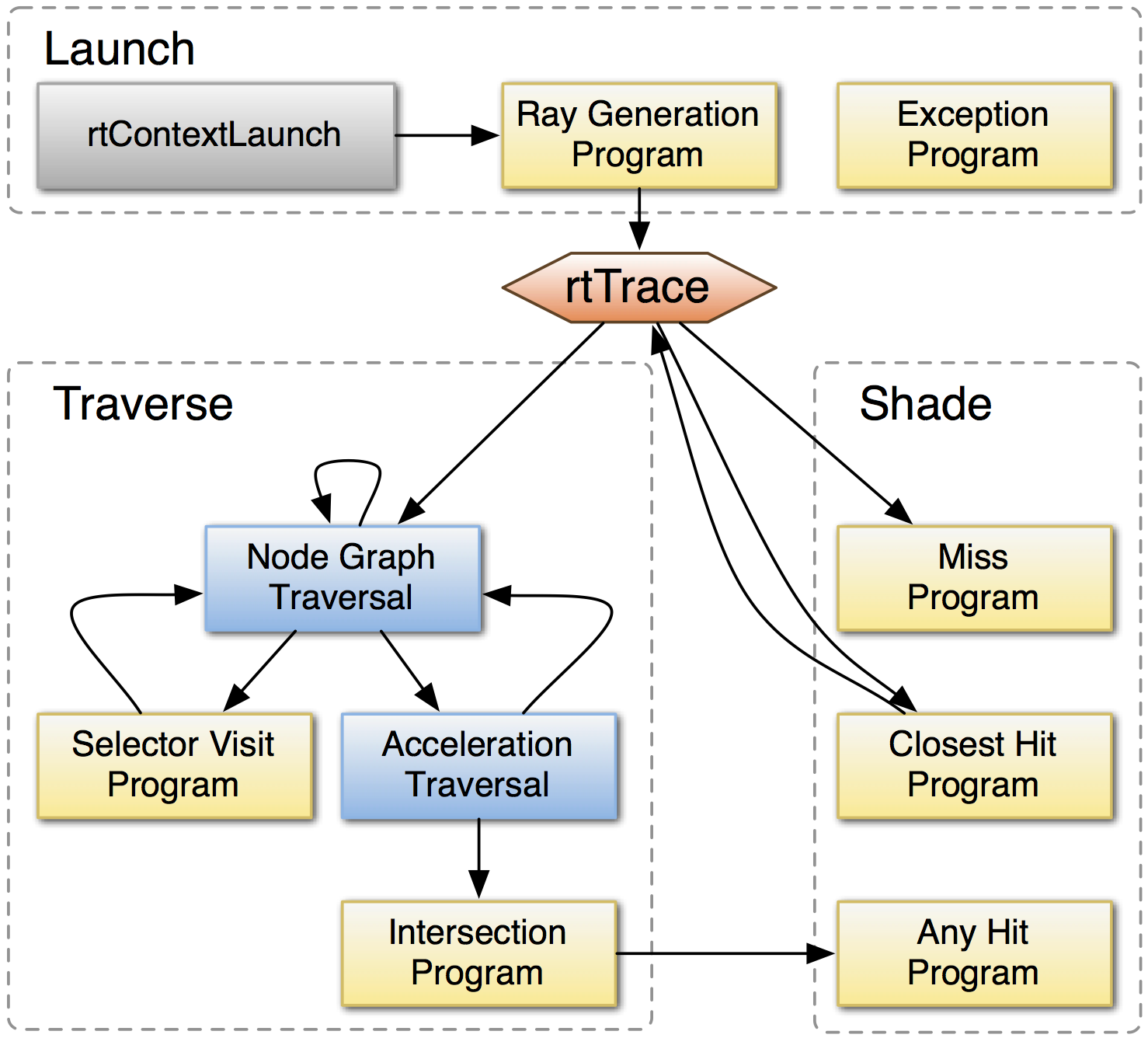
OptiX makes GPU ray tracing accessible
- accelerates ray-geometry intersections
- simple : single-ray programming model
- "...free to use within any application..."
- access RT Cores[1] with OptiX 6.0.0+ via RTX™ mode
NVIDIA expertise:
- ~linear scaling up to 4 GPUs
- acceleration structure creation + traversal (Blue)
- instanced sharing of geometry + acceleration structures
- compiler optimized for GPU ray tracing
Opticks provides (Yellow):
- ray generation program
- ray geometry intersection+bbox programs
[1] Turing RTX GPUs
Geant4OpticksWorkflow
Opticks : Translates G4 Optical Physics to CUDA/OptiX
GPU Resident Photons
- Seeded on GPU
- associate photons -> gensteps (via seed buffer)
- Generated on GPU, using genstep param:
- number of photons to generate
- start/end position of step
- Propagated on GPU
- Only photons hitting PMTs copied to CPU
Thrust: high level C++ access to CUDA

OptiX : single-ray programming model -> line-by-line translation
- CUDA Ports of Geant4 classes
- G4Cerenkov (only generation loop)
- G4Scintillation (only generation loop)
- G4OpAbsorption
- G4OpRayleigh
- G4OpBoundaryProcess (only a few surface types)
- Modify Cherenkov + Scintillation Processes
- collect genstep, copy to GPU for generation
- avoids copying millions of photons to GPU
- Scintillator Reemission
- fraction of bulk absorbed "reborn" within same thread
- wavelength generated by reemission texture lookup
- Opticks (OptiX/Thrust GPU interoperation)
- OptiX : upload gensteps
- Thrust : seeding, distribute genstep indices to photons
- OptiX : launch photon generation and propagation
- Thrust : pullback photons that hit PMTs
- Thrust : index photon step sequences (optional)
G4VSolid -> CUDA Intersect Functions for ~10 Primitives
- 3D parametric ray : ray(x,y,z;t) = rayOrigin + t * rayDirection
- implicit equation of primitive : f(x,y,z) = 0
- -> polynomial in t , roots: t > t_min -> intersection positions + surface normals
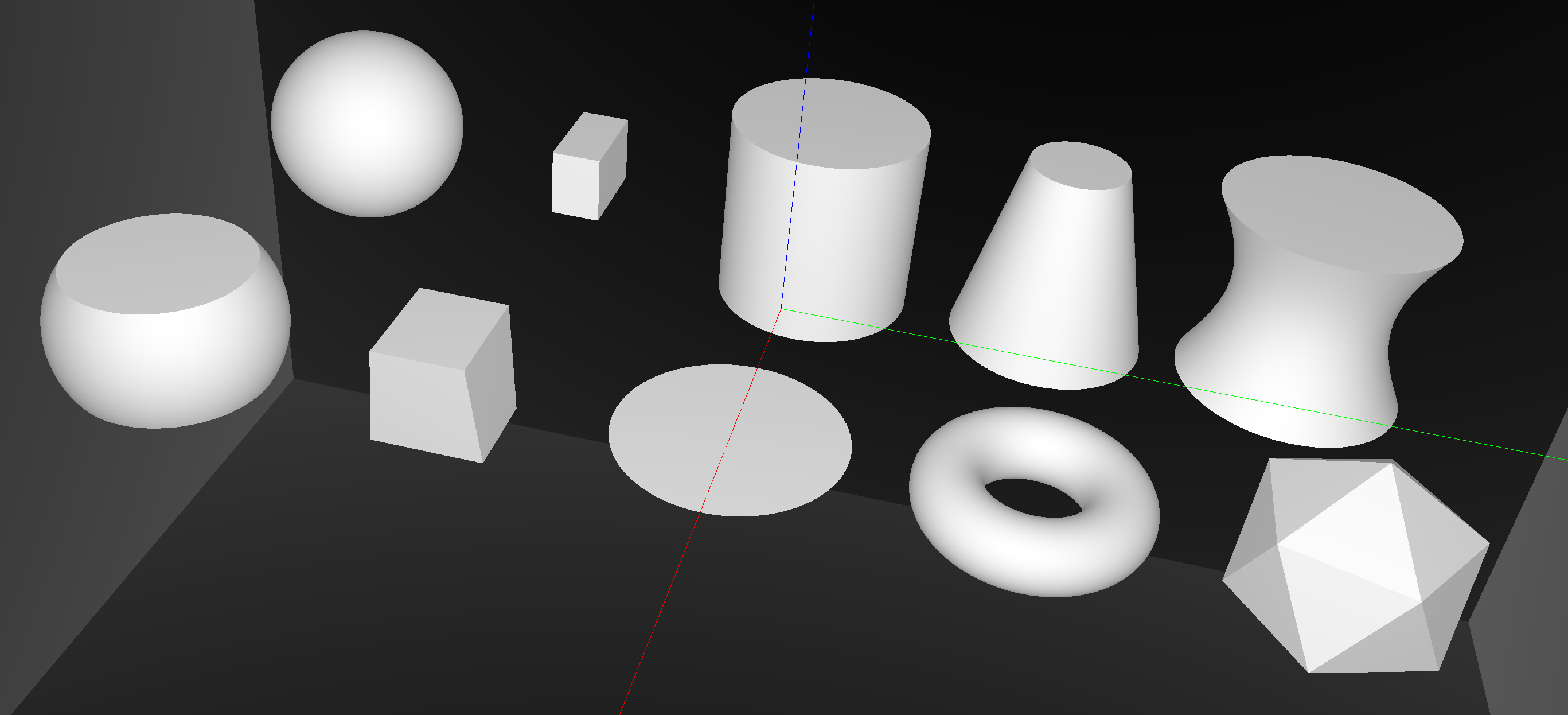
Sphere, Cylinder, Disc, Cone, Convex Polyhedron, Hyperboloid, Torus, ...
G4Boolean -> CUDA/OptiX Intersection Program Implementing CSG
Outside/Inside Unions
dot(normal,rayDir) -> Enter/Exit
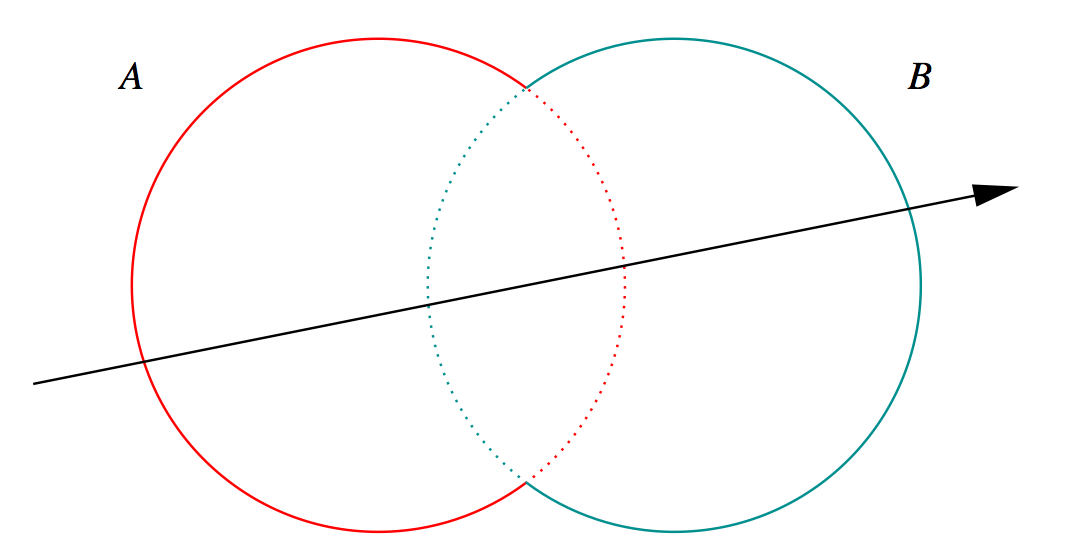

- A + B boundary not inside other
- A * B boundary inside other
Complete Binary Tree, pick between pairs of nearest intersects:
| UNION tA < tB | Enter B | Exit B | Miss B |
|---|---|---|---|
| Enter A | ReturnA | LoopA | ReturnA |
| Exit A | ReturnA | ReturnB | ReturnA |
| Miss A | ReturnB | ReturnB | ReturnMiss |
- Nearest hit intersect algorithm [1] avoids state
- sometimes Loop : advance t_min , re-intersect both
- classification shows if inside/outside
- Evaluative [2] implementation emulates recursion:
- recursion not allowed in OptiX intersect programs
- bit twiddle traversal of complete binary tree
- stacks of postorder slices and intersects
- Identical geometry to Geant4
- solving the same polynomials
- near perfect intersection match
- [1] Ray Tracing CSG Objects Using Single Hit Intersections, Andrew Kensler (2006)
- with corrections by author of XRT Raytracer http://xrt.wikidot.com/doc:csg
- [2] https://bitbucket.org/simoncblyth/opticks/src/tip/optixrap/cu/csg_intersect_boolean.h
- Similar to binary expression tree evaluation using postorder traverse.
Opticks : Translates G4 Geometry to GPU, Without Approximation
Materials/Surfaces -> GPU Texture
Material/Surface/Scintillator properties
- interpolated to standard wavelength domain
- interleaved into "boundary" texture
- "reemission" texture for wavelength generation
Material/surface boundary : 4 indices
- outer material (parent)
- outer surface (inward photons, parent -> self)
- inner surface (outward photons, self -> parent)
- inner material (self)
Primitives labelled with unique boundary index
- ray primitive intersection -> boundary index
- texture lookup -> material/surface properties
simple/fast properties + reemission wavelength
G4 Structure Tree -> Instance+Global Arrays -> OptiX
Group structure into repeated instances + global remainder:
- auto-identify repeated geometry with "progeny digests"
- JUNO : 9 distinct instances + 1 global
- instance transforms used in OptiX/OpenGL geometry
instancing -> huge memory savings for JUNO PMTs
j1808_top_rtx
j1808_top_ogl
Validation of Opticks Simulation by Comparison with Geant4
Random Aligned Bi-Simulation
Same inputs to Opticks and Geant4:
- CPU generated photons
- GPU generated randoms, fed to Geant4
Common recording into OpticksEvents:
- compressed photon step record, up to 16 steps
- persisted as NumPy arrays for python analysis
Aligned random consumption, direct comparison:
- ~every scatter, absorb, reflect, transmit at matched positions, times, polarization, wavlen
Bi-simulations of all JUNO solids, with millions of photons
- mis-aligned histories
- mostly < 0.25%, < 0.50% for largest solids
- deviant photons within matched history
- < 0.05% (500/1M)
Primary sources of problems
- grazing incidence, edge skimmers
- incidence at constituent solid boundaries
Primary cause : float vs double
Geant4 uses double everywhere, Opticks only sparingly (observed double costing 10x slowdown with RTX)
Conclude
- neatly oriented photons more prone to issues than realistic ones
- perfect "technical" matching not feasible
- instead shift validation to more realistic full detector "calibration" situation
scan-pf-check-GUI-TO-SC-BT5-SD
Recording the steps of Millions of Photons
Compression Essential
Domain compression to fit in VRAM
- 16 step records per photon -> 256 bytes/photon
- 10M photons -> 2.56 GB
4-bit History Flags at Each Step
BT : boundary BR : boundary reflect SC : bulk scatter AB : bulk absorb SD : surface detect SA : surface absorb
- seqhis
- 64-bit integer history sequence
Up to 16 steps of the photon propagation are recorded.
Photon Array : 4 * float4 = 512 bits/photon
- float4: position, time [32 * 4 = 128 bits]
- float4: direction, weight
- float4: polarization, wavelength
- float4: flags: material, boundary, history
Step Record Array : 2 * short4 = 2*16*4 = 128 bits/record
- short4: position, time (snorm compressed) [4*16 = 64 bits]
- uchar4: polarization, wavelength (uchar compressed) [4*8 = 32 bits]
- uchar4: material, history flags [4*8 = 32 bits]
Compression uses known domains of position (geometry center, extent), time (0:200ns), wavelength, polarization.
scan-pf-check-GUI-TO-BT5-SD
Performance : Scanning from 1M to 400M Photons
Test Hardware + Software
Workstation
- DELL Precision 7920T Workstation
- Intel Xeon Gold 5118, 2.3GHz, 48 cores, 62G
- NVIDIA Quadro RTX 8000 (48G)
Software
- Opticks 0.0.0 Alpha
- Geant4 10.4p2
- NVIDIA OptiX 6.5.0
- NVIDIA Driver 435.21
- CUDA 10.1
IHEP GPU Cluster
- 10 nodes of 8x NVIDIA Tesla GV100 (32G)
Full JUNO Analytic Geometry j1808v5
- "calibration source" genstep at center of scintillator
Production Mode : does the minimum
- only saves hits
- skips : genstep, photon, source, record, sequence, index, ..
- no Geant4 propagation (other than at 1M for extrapolation)
Multi-Event Running, Measure:
- interval
- avg time between successive launches, including overheads: (upload gensteps + launch + download hits)
- launch
- avg of 10 OptiX launches
- overheads < 10% beyond 20M photons
NVIDIA Quadro RTX 8000 (48G)
for loaning the card
scan-pf-1_NHit
Photon Launch Size : VRAM Limited
NVIDIA Quadro RTX 8000 (48 GB)
- photon 4*4 floats : 64 bytes
- curandState : 48 bytes
400M photons x 112 bytes ~ 45G
scan-pf-1_Opticks_vs_Geant4 2
| JUNO analytic, 400M photons from center | Speedup | |
|---|---|---|
| Geant4 Extrap. | 95,600 s (26 hrs) | |
| Opticks RTX ON (i) | 58 s | 1650x |
scan-pf-1_Opticks_Speedup 2
| JUNO analytic, 400M photons from center | Speedup | |
|---|---|---|
| Opticks RTX ON (i) | 58s | 1650x |
| Opticks RTX OFF (i) | 275s | 350x |
| Geant4 Extrap. | 95,600s (26 hrs) | |
scan-pf-1_RTX_Speedup
| 5x Speedup from RTX with JUNO analytic geometry |
Useful Speedup > 1500x : But Why Not Giga Rays/s ? (1 Photon ~10 Rays)
100M photon RTX times, avg of 10
| Launch times for various geometries | |||
|---|---|---|---|
| Geometry | Launch (s) | Giga Rays/s | Relative to ana |
| JUNO ana | 13.2 | 0.07 | |
| JUNO tri.sw | 6.9 | 0.14 | 1.9x |
| JUNO tri.hw | 2.2 | 0.45 | 6.0x |
| Boxtest ana | 0.59 | 1.7 | |
| Boxtest tri.sw | 0.62 | 1.6 | |
| Boxtest tri.hw | 0.30 | 3.3 | 1.9x |
- ana : Opticks analytic CSG (SM)
- tri.sw : software triangle intersect (SM)
- tri.hw : hardware triangle intersect (RT)
JUNO 15k triangles, 132M without instancing
Simple Boxtest geometry gets into ballpark
- NVIDIA claim : 10 Giga Rays/s with RT Core
- -> 1 Billion photons per second
- RT cores : built-in triangle intersect + 1-level of instancing
- flatten scene model to avoid SM<->RT roundtrips ?
OptiX Performance Tools and Tricks, David Hart, NVIDIA https://developer.nvidia.com/siggraph/2019/video/sig915-vid
Where Next for Opticks ?
NVIDIA OptiX 7 : Entirely new API
- introduced August 2019
- low-level CUDA-centric thin API
- near perfect scaling to 4 GPUs, for free
JUNO+Opticks into Production
- optimize geometry modelling for RTX
- full JUNO geometry validation iteration
- JUNO offline integration
- optimize GPU cluster throughput:
- split/join events to fit VRAM
- job/node/multi-GPU strategy
- support OptiX 7, find multi-GPU load balancing approach
Geant4+Opticks Integration : Work with Geant4 Collaboration
- finalize Geant4+Opticks extended example
- aiming for Geant4 distrib
- prototype Genstep interface inside Geant4
- avoid customizing G4Cerenkov G4Scintillation
Alpha Development ------>-----------------> Robust Tool
- many more users+developers required (current ~10+1)
- if you have an optical photon simulation problem ...
- start by joining : https://groups.io/g/opticks
Drastically Improved Optical Photon Simulation Performance...
How is >1500x possible ?
Progress over 30 yrs, Billions of Dollars
- industry funded : game, film, design, ...
- re-purposed by translating geometry to GPU
- tree of C++ objects -> arrays -> BVH
Photon Simulation ideally suited to GPU
- millions of photons -> abundantly parallel
- simple phys. -> small stack -> many in flight
- decoupled -> no synchronization
Three revolutions reinforcing each other:
- games -> graphics revolution -> GPU -> cheap TFLOPS
- internet scale big datasets -> ML revolution
- computer vision revolution for autonomous vehicles
Deep rivers of development, ripe for re-purposing
- analogous problems -> solutions
- experience across fields essential to find+act on analogies
Example : DL denoising for faster ray trace convergence
- analogous to hit aggregation
- skip the hits, jump straight to DL smoothed probabilities
- blurs the line between simulation and reconstruction
Re-evaluate long held practices in light of new realities:
- large ROOT format (C++ object) MC samples repeatedly converted+uploaded to GPU for DL training ... OR:
- small Genstep NumPy arrays uploaded, dynamically simulated into GPU hit arrays in fractions of a second
Overview + Links
Highlights
- Benefit from hardware accelerated ray tracing
- Opticks > 1500x Geant4 (one Turing GPU)

Opticks : state-of-the-art GPU ray tracing applied to optical photon simulation and integrated with Geant4, giving a leap in performance that eliminates memory and time bottlenecks.

- Drastic speedup -> better detector understanding -> greater precision
- any simulation limited by optical photons can benefit
- more photon limited -> more overall speedup (99% -> 100x)

| https://bitbucket.org/simoncblyth/opticks | code repository |
| https://simoncblyth.bitbucket.io | presentations and videos |
| https://groups.io/g/opticks | forum/mailing list archive |
| email:opticks+subscribe@groups.io | subscribe to mailing list |
geocache_360
Outline of Graphics/GPU background + Application to neutrino telescopes

- GPU + Parallel Processing Background
- Amdahls "Law" : Expected speedup limited by serial processing
- Understanding GPU Graphical Origins -> Effective GPU Computation
- CPU Optimizes Latency, GPU Optimizes Throughput
- How to make effective use of GPUs ? Parallel/Simple/Uncoupled
- GPU Demands Simplicity (Arrays) -> Big Benefits : NumPy + CuPy
- Survey of High Level General Purpose CUDA Packages
- Graphics History/Background
- 50 years of rendering progress
- 2018 : NVIDIA RTX : Project Sol Demo
- Monte Carlo Path Tracing in Movie Production
- Fundamental "Rendering Equation" of Computer Graphics
- Neumann Series solution of Rendering Equation
- Noise : Problem with Monte Carlo Path Tracing
- NVIDIA OptiX Denoiser
- Physically Based Rendering Book : Free Online
- Optical Simulations : Graphics vs Physics
- Neutrino Telescope Optical simulations
- Giga-photon propagations : Re-usable photon "snapshots"
- Opticks Rayleigh Scattering : CUDA line-by-line port of G4OpRayleigh
- Developing a photon "snapshot" cache
- Photon Mapping
- Summary
Amdahls "Law" : Expected Speedup Limited by Serial Processing
S(n) Expected Speedup

- P
- parallelizable proportion
- 1-P
- non-parallelizable portion
- n
- parallel speedup factor
optical photon simulation, P ~ 99% of CPU time
- -> potential overall speedup S(n) is 100x
- even with parallel speedup factor >> 1500x
Must consider processing "big picture"
- remove bottlenecks one by one
- re-evaluate "big picture" after each
Understanding GPU Graphical Origins -> Effective GPU Computation
OpenGL Rasterization Pipeline
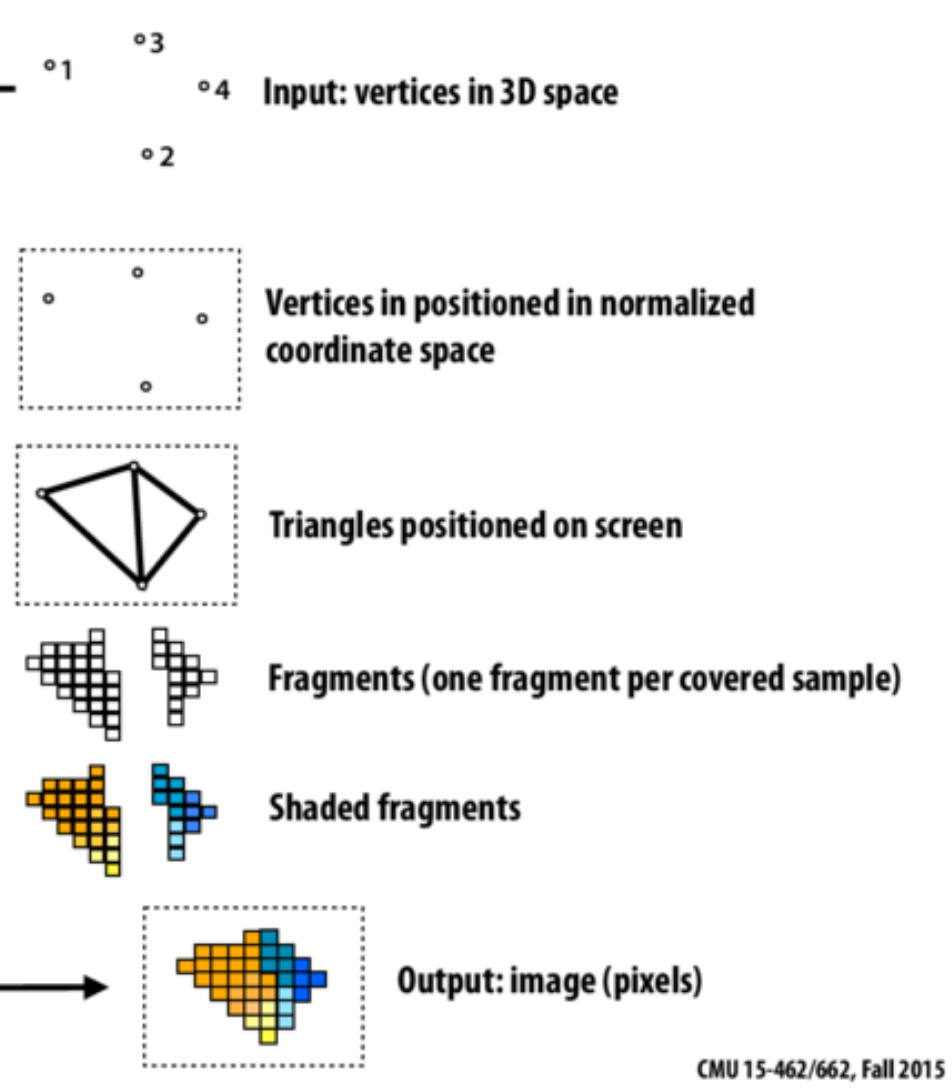
GPUs evolved to rasterize 3D graphics at 30/60 fps
- 30/60 "launches" per second, each handling millions of items
- literally billions of small "shader" programs run per second
Simple Array Data Structures (N-million,4)
- millions of vertices, millions of triangles
- vertex: (x y z w)
- colors: (r g b a)
Constant "Uniform" 4x4 matrices : scaling+rotation+translation
- 4-component homogeneous coordinates -> easy projection
Graphical Experience Informs Fast Computation on GPUs
- array shapes similar to graphics ones are faster
- "float4" 4*float(32bit) = 128 bit memory reads are favored
- Opticks photons use "float4x4" just like 4x4 matrices
- GPU Launch frequency < ~30/60 per second
- avoid copy+launch overheads becoming significant
- ideally : handle millions of items in each launch
CPU Optimizes Latency, GPU Optimizes Throughput
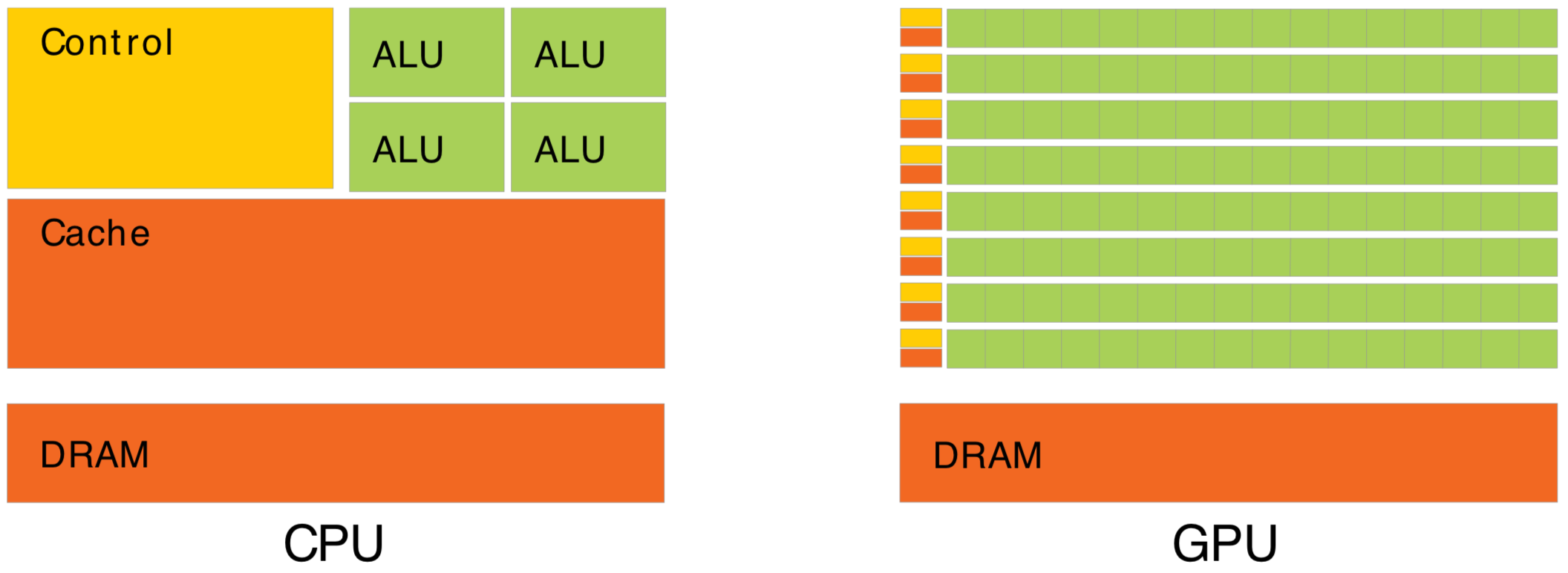
Waiting for memory read/write, is major source of latency...
- CPU : latency-oriented : Minimize time to complete single task : avoid latency with caching
- complex : caching system, branch prediction, speculative execution, ...
- GPU : throughput-oriented : Maximize total work per unit time : hide latency with parallelism
- many simple processing cores, hardware multithreading, SIMD (single instruction multiple data)
- simpler : lots of compute (ALU), at expense of cache+control
- can tolerate latency, by assuming abundant other tasks to resume : design assumes parallel workload
- Totally different processor architecture -> Total reorganization of data and computation
- major speedups typically require total rethink of data structures and computation
How to Make Effective Use of GPUs ? Parallel / Simple / Uncoupled
Optical Photon Simulation
- Abundant parallelism
- Many millions of photons
- Low register usage
- Simple optical physics, texture lookups
- Little/No synchronization
- Independent photons -> None
- Minimize CPU<->GPU copies
- geometry copied at initialization
- gensteps copied once per event
- only hits copied back
~perfect match for GPU acceleration
- Abundant parallelism
- many thousands of tasks (ideally millions)
- Low register usage : otherwise limits concurrent threads
- simple kernels, avoid branching
- Little/No Synchronization
- avoid waiting, avoid complex code/debugging
- Minimize CPU<->GPU copies
- reuse GPU buffers across multiple CUDA launches

How Many Threads to Launch ?
- can (and should) launch many millions of threads
- largest Opticks launch : 400M threads, at VRAM limit
- maximum thread launch size : so large its irrelevant
- maximum threads inflight : #SM*2048 = 80*2048 ~ 160k
- best latency hiding when launch > ~10x this ~ 1M
Understanding Throughput-oriented Architectures https://cacm.acm.org/magazines/2010/11/100622-understanding-throughput-oriented-architectures/fulltext
NVIDIA Titan V: 80 SM, 5120 CUDA cores
GPU Demands Simplicity (Arrays) -> Big Benefits : NumPy + CuPy
Array Serialization Benefits
Persist everything to file -> fast development cycle
- data portability into any environment
- interactive debug/analysis : NumPy,IPython
- flexible testing
Can transport everything across network:
- production flexibility : distributed compute
Arrays for Everything -> direct access debug
- (num_photons,4,4) float32
- (num_photons,16,2,4) int16 : step records
- (num_photons,2) uint64 : history flags
- (num_gensteps,6,4) float32
- (num_csgnodes,4,4) float32
- (num_transforms,3,4,4) float32
- (num_planes,4) float32
- ...
- Separate address space -> cudaMemcpy -> Serialization
- upload/download : host(CPU)<->device(GPU)
- Serialize everything -> Arrays
- Many small tasks -> Arrays
- Random Access/Order undefined -> Arrays
Object-oriented : mixes data and compute
- complicated serialization
- good for complex systems, up to ~1000 objects
Array-oriented : separate data from compute
- inherent serialization + simplicity
- good for millions of element systems
NumPy : standard array handling package
- simple .npy serialization
- read/write NumPy arrays from C++ https://github.com/simoncblyth/np/blob/master/NP.hh
https://realpython.com/numpy-array-programming/
Survey of High Level General Purpose CUDA Packages
CuPy : Simplest CUDA Interface
- https://cupy.chainer.org/
- NumPy API accelerated by CUDA stack
- plus some of SciPy API

- develop processing with NumPy on CPU
- switch numpy->cupy to test on GPU
- great for prototyping
"Production" CuPy ? Depends on requirements:
- integrations (eg Geant4, OpenGL, ...)
- control + performance
- Learn CUDA basics (kernels, thread+memory hierarchy, ...)
- BUT: base development on higher level libs -> faster start
C++ Based Interfaces to CUDA
- Thrust : https://developer.nvidia.com/Thrust
- C++ interface to CUDA performance
- high-level abstraction : reduce, scan, sort
- CUB : http://nvlabs.github.io/cub/
- CUDA C++ specific, GPU less hidden
- MGPU : https://github.com/moderngpu/moderngpu
- teaching tool : examples of CUDA algorithms
Mature NVIDIA Basis Libraries
- cuRAND, cuFFT, cuBLAS, cuSOLVER, cuTENSOR, ...
- https://developer.nvidia.com/gpu-accelerated-libraries
RAPIDS : New NVIDIA "Suite" of open source data science libs
- GPU-accelerated open source data science suite
- "... end-to-end data science workflows..." http://rapids.ai/
- cuDF : GPU dataframe library, Pandas-on-GPU
Rendering Five Decades of Research 1
Rendering Five Decades of Research 2
Milestones over 50 years of CG
Improving image realism, speed
- 1968 : Appel : ray casting
- 1979 : Whitted : recursive ray tracing
- 1986 : Kajiya : The Rendering Equation
- 2018 : NVIDIA RTX : real-time cinematic path tracing with one GPU
Image rendering : Applied photon simulation
Project Sol
(2018) NVIDIA RTX
Project Sol : NVIDIA RTX Demo
real-time cinematic raytracing on single GPU ( NVIDIA RTX 2080Ti)
Path Tracing in Production 1
Path Tracing in Production 2
Monte Carlo Path Tracing
- state-of-the-art rendering technique
- random sampling (Monte Carlo method)
- numerical solution of "The Rendering Eqn."
Movies ≈ monte carlo optical photon simulations
The Rendering Equation 1
The Rendering Equation 2
Samples per Pixel 1
Samples per Pixel 2
Monte Carlo Path Tracing
- fantastically general : any geometry + lighting/surface effect
- BUT : slow convergence, 1/sqrt(N_samples)
- many samples per pixel
- noise
NVIDIA OptiX AI Denoiser 1
NVIDIA OptiX AI Denoiser 2
NVIDIA OptiX AI Denoiser
- https://developer.nvidia.com/optix-denoiser
- reduce time to render quality image
- deep learning network trained on many thousands of images
- benefits from NVIDIA GPU : Tensor Cores
- key enabler of real-time cinematic raytracing
https://research.nvidia.com/publication/interactive-reconstruction-monte-carlo-image-sequences-using-recurrent-denoising
Physically Based Rendering Book : www.pbr-book.org
Free Online Book
- recommended introduction
- book awarded an Oscar (Film Academy Award)
Optical Simulation : Computer Graphics vs Physics
| CG Rendering "Simulation" | Particle Physics Simulation |
|---|---|
| simulates: image formation, vision | simulates photons: generation, propagation, detection |
| (red, green, blue) | wavelength range eg 400-700 nm |
| ignore polarization | polarization vector propagated throughout |
| participating media: clouds,fog,fire [1] | bulk scattering: Rayleigh, MIE |
| human exposure times | nanosecond time scales |
| equilibrium assumption | transient phenomena |
| ignores light speed, time | arrival time crucial, speed of light : 30 cm/ns |
- handling of time is the crucial difference
Despite differences many techniques+hardware+software directly applicable to physics eg:
- GPU accelerated ray tracing (NVIDIA OptiX)
- GPU accelerated property interpolation via textures (NVIDIA CUDA)
- GPU acceleration structures (NVIDIA BVH)
Potentially Useful CG techniques for "billion photon simulations"
- irradiance caching, photon mapping, progressive photon mapping
[1] search for: "Volumetric Rendering Equation"
Neutrino Telescope Optical Simulations : Giga-Photon Propagations
Re-usable photon "snapshots" ?
- full simulation -> photon "snapshot" cache
- when crossing virtual segmented "shells" ?
- collect direction,polarization onto positioned segments
- what shape/segmentation ?
- lots of duplicated information
- when scattering (pre or post parameters)
- collect position,direction,polarization
- no shells, more involved lookup
- when crossing virtual segmented "shells" ?
- fast no-photon simulation
- orient "snapshot" to the primary
- "snapshots" near sensors -> resume propagation
- times, incidence angles at sensors -> hits
GPU "snapshot" cache data structure:
- photon lists, binned PDFs ?
- k-d tree (for nearest neighbor searches)
- Cherenkov light generation
- radioactive + biological backgrounds
- propagation : scattering + absorption (billions)
- direct light (unscattered) : fast
- indirect (scattered) : slow
- detection on sparse sensors
Opticks as drop in fast replacement for Geant4
Full+fast GPU accelerated simulation:
- Cerenkov generation, Rayleigh scattering, absorption
- angle dependent sensor collection efficiency culling
- BUT: launch size, VRAM limited: 48G ≈ 400M photons
Re-usage is caching optimization, still need full propagation:
- populate the cache
- validate the trickery
- re-usage reduces need for expensive propagations
Opticks Rayleigh Scattering : CUDA line-by-line port of G4OpRayleigh
130 __device__ void rayleigh_scatter(Photon &p, curandState &rng)
131 {
137 float3 newDirection, newPolarization ;
139 float cosTheta ;
141 do {
145 newDirection = uniform_sphere(&rng);
146 rotateUz(newDirection, p.direction );
151
152 float constant = -dot(newDirection,p.polarization);
153 newPolarization = p.polarization + constant*newDirection ;
154
155 // newPolarization
156 // 1. transverse to newDirection (as that component is subtracted)
157 // 2. same plane as old p.polarization and newDirection (by construction)
158 //
... ... corner case elided ...
182 if(curand_uniform(&rng) < 0.5f) newPolarization = -newPolarization ;
184
185 newPolarization = normalize(newPolarization);
189 cosTheta = dot(newPolarization,p.polarization) ;
190
191 } while ( cosTheta*cosTheta < curand_uniform(&rng)) ;
192
193 p.direction = newDirection ;
194 p.polarization = newPolarization ;
195 }
Have to persist the polarization vector, to truly resume a propagation
- could persist pre-scatter : polarization, direction
https://bitbucket.org/simoncblyth/opticks/src/master/optixrap/cu/rayleigh.h
Developing a photon "snapshot" cache
Virtual shell OR scatter-based ?
What is VRAM of available GPUs ?
- will constrain possibilities
Literature Search/Learning
- photon mapping (CG style)
- irradiance caching (CG style)
- Z-order curve, Morton codes
- kd-tree, spatial hashing, ...
Gain Experience
- find/tryout open source CUDA implementations
- compare: size, convenience, speed
- try: domain compression, bit-squeezing
-> informed decisions
Where/when/what to collect ?
- tetrahedral volumetric meshes (tet-mesh)
- inherent segmentation
- natural adaptive resolution
- triangle faces : Giga-rays/s intersection (RT Cores)[1]
- good for general light field capture
- "concentric" spheres/cylinders/cones oriented to primary
- natural for exploiting track axis rotational symmetry
- at scatters (pre-scatter/post-scatter parameters)
- position, direction, polarization
- can generate post from pre, but not v.v.
- collect photons OR aggregate binned PDFs ?
- PDF->CDF->generate photons (like Opticks "gensteps")
Too many options: experimentation needed to iterate towards solution
[1] RTX Beyond Ray Tracing: Exploring the Use of Hardware Ray Tracing Cores for Tet-Mesh Point Location https://www.willusher.io/publications/rtx-points
Photon Mapping 1
Photon Mapping 2
Conclusion
Highlights
- Benefit from hardware accelerated ray tracing
- Opticks > 1500x Geant4 (one Turing GPU)

Opticks : state-of-the-art GPU ray tracing applied to optical photon simulation and integrated with Geant4, eliminating memory and time bottlenecks.
- neutrino telescope simulation can benefit drastically from Opticks
- Drastic speedup -> better detector understanding -> greater precision
- more photon limited -> more overall speedup ( 99.9% -> 1000x )
- graphics : rich source of techniques, inspiration, CUDA code to try

| https://bitbucket.org/simoncblyth/opticks | code repository |
| https://simoncblyth.bitbucket.io | presentations and videos |
| https://groups.io/g/opticks | forum/mailing list archive |
| email:opticks+subscribe@groups.io | subscribe to mailing list |